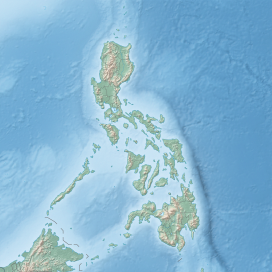Mount Panay is a potentially active stratovolcano located in the province of Batangas, Philippines.
| Mount Panay | |
|---|---|
 | |
| Highest point | |
| Elevation | 501 m (1,644 ft)[1][2] |
| Listing | potentially active volcano |
| Coordinates | 13°43′23″N 120°53′35″E / 13.723°N 120.893°E |
| Geography | |
| Location | Luzon |
| Country | Philippines |
| Region | Calabarzon |
| Province | Batangas |
| Geology | |
| Mountain type | Stratovolcano |
| Volcanic arc | Luzon Volcanic Arc |
| Last eruption | Middle Pleistocene |
Geography
editPanay is located south of Taal Lake, in the province of Batangas, Philippines.
It is located at the southern end of the Calumpang Peninsula, which forms the western side of Batangas Bay, at latitude 13.723°N (13°43'24"N), longitude 120.893°E (120°53'36"E).
Physical features
editPanay is a forested, low, andesitic stratovolcano, on the western side of Batangas Bay, which could be a breached caldera inundated by the sea.
Panay has an elevation of 501 metres (1,644 feet) asl.
Panay is reported to be strongly solfataric at present.
Eruptions
editLast eruptive activity is thought to be Pleistocene, about 500,000 years ago.[2]
There have been no historical eruptions.
Geology
editRock type is predominantly andesite.
Tectonically, Panay lies at the intersection of two major regional trends, the Bataan Lineament and the Palawan-Macolod Lineament.
Batangas Bay, which includes Panay, may be a drowned caldera.
Listings
editSmithsonian Institution lists Panay as Pleistocene - Fumarolic.[2]
Philippines Institute of Volcanology and Seismology (Phivolcs) lists Panay as Inactive.[1]
See also
editReferences
edit- ^ a b "Inactive Volcanoes; Part 6". Philippine Institute of Volcanology and Seismology. 30 July 2008. Retrieved 24 March 2016.
- ^ a b c "Panay". Global Volcanism Program. Smithsonian Institution. Retrieved 2021-06-25.
